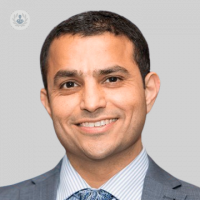How is an ankle replacement operation performed?
Written in association with:Here, esteemed expert in foot and ankle surgery, Mr Kailash Devalia, delves into how ankle replacement surgery is performed, whilst also outlining the associated benefits and risks.

What is an ankle replacement?
Ankle replacement, also known as total ankle arthroplasty, is a surgical procedure designed to alleviate severe pain and restore function in the ankle joint, typically resulting from arthritis, trauma, or degenerative conditions. This advanced medical intervention has become increasingly popular as an alternative to ankle fusion, offering improved mobility and quality of life for patients.
The ankle joint, composed of the tibia, fibula, and talus bones, plays a crucial role in movement and weight-bearing. When damaged by arthritis or injury, it can lead to chronic ankle pain, swelling, and impaired mobility. Traditional treatment methods, such as medication, physical therapy, and lifestyle modifications, often provide insufficient relief for severe cases, making surgical options necessary.
How is an ankle replacement operation performed?
Ankle replacement involves removing the damaged ankle bone and cartilage and replacing them with prosthetic components made of metal and plastic. These artificial parts mimic the natural joint's function, allowing smoother movement and reducing pain. The procedure typically requires a hospital stay of several days, followed by a rehabilitation period that includes physical therapy to restore strength and flexibility in the ankle.
An ankle replacement is performed through an incision over the front of the ankle. The surgery takes between one and two hours. When you wake from surgery, you will have a below knee partial cast, which may later be changed into a full cast at discharge.
You may have to wear a cast for a period of up to six weeks. In some circumstances, your surgeon may choose not to use a cast but may use a walker boot instead. You are likely to need crutches or a frame to help you walk.

Depending on your situation, I may allow you to fully weight bear in the cast once the wound has healed. During your first appointment, I would arrange for an MRI or CT scan after careful history and examination to establish the diagnosis. I would discuss the treatment options based on your individual needs and scan findings.
If you require an ankle replacement, I would go through the details of your surgery including benefits, risks and post operative rehabilitation. I use implants with proven benefits and long term survival rate. During your operation, you will have nerve blocks to reduce postoperative pain.
Your first outpatient appointment after surgery will usually be after two weeks for a wound check. You will also be given an appointment to see me in the out patients clinic after around six to eight weeks following your surgery. My physiotherapy team would work with you to regain functional range of movements following cast removal.
Who is the ideal candidate for an ankle replacement?
Ideal candidates for ankle replacement are usually those with advanced arthritis who have not responded well to conservative treatments. The ideal candidate is often older, less active, and without significant deformities or bone loss. However, advancements in surgical techniques and prosthetic designs are expanding the eligibility criteria.
What are the associated benefits and risks?
One of the key benefits of ankle replacement over fusion is the preservation of joint motion. While ankle fusion effectively relieves pain, it eliminates movement in the joint, potentially leading to adjacent joint stress and arthritis. Ankle replacement, by maintaining mobility, can result in a more natural gait and reduce the risk of complications in surrounding joints.
Despite its benefits, ankle replacement carries risks such as infection, implant loosening, and nerve damage. Long-term success depends on factors like surgical precision, patient adherence to rehabilitation, and the durability of the prosthetic components.
To book an appointment with Mr Kailash Devalia today, visit his Top Doctors profile.


